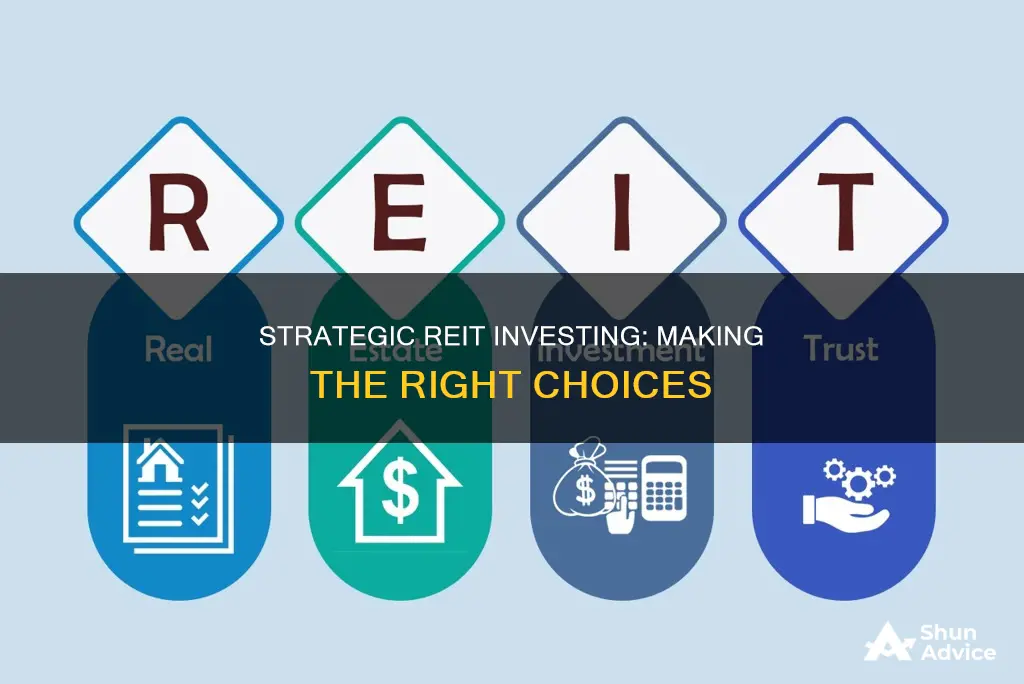
Real estate investment trusts (REITs) are an attractive investment option for those looking to diversify their portfolio and generate a steady stream of income. REITs are companies that own and/or manage income-producing real estate, and they are required by law to distribute at least 90% of their taxable income to shareholders in the form of dividends. This makes them an excellent counterbalance to stocks, bonds, and cash.
When considering investing in REITs, it is important to evaluate the different types available, including equity REITs, mortgage REITs, and hybrid REITs, as well as the various sectors they operate in, such as healthcare, retail, and hospitality. Additionally, investors should analyse the management team's track record, the REIT's financials, performance history, and the sector it operates in.
While REITs offer high dividend yields and long-term capital appreciation, it is important to be aware of the potential drawbacks, including high debt, low growth, and tax implications.
| Characteristics | Values |
|---|---|
| Types of REITs | Equity REITs, Mortgage REITs, Hybrid REITs, Publicly Traded REITs, Public Non-Traded REITs, Private REITs |
| Benefits of Investing in REITs | High and Steady Dividend Income, Long-Term Capital Appreciation, Low Correlation with Other Assets, High Liquidity, Low Minimum Investment |
| REIT Requirements | Must have at least 100 shareholders after one year of existence, Must distribute at least 90% of taxable income to shareholders as dividends annually, Must have at least 75% of total assets invested in real estate or cash, Must earn at least 75% of gross income from real estate, No more than 50% of shares can be held by five or fewer individuals in the last half of the taxable year |
| REIT Earnings and Performance | Earnings and ability to pay dividends measured by net income, funds from operations (FFO), and adjusted FFO (AFFO), Earnings growth driven by higher revenues, lower costs, and new business opportunities, such as higher occupancy rates and increased rents |
| REIT Taxation | REIT companies pay no taxes, but their investors must pay income taxes on dividends received unless held in a tax-advantaged account |
| REIT Investment Advice | Consider management track record, financials and performance history, sector and investment strategy, and risk management practices |
What You'll Learn

Understand the different types of REITs
Understanding the different types of REITs is essential when making investment choices. REITs, or real estate investment trusts, are companies that own or finance income-producing real estate. There are two main types of REITs: equity REITs and mortgage REITs (mREITs).
Equity REITs make up the majority of REITs and generate income by collecting rent and selling properties they own for the long term. They provide investors with access to diverse portfolios of income-producing assets, such as office buildings, shopping centres, and apartment complexes.
On the other hand, mREITs focus on investing in mortgages or mortgage securities tied to commercial and/or residential properties. They provide financing for income-producing real estate and earn income from the interest on these investments.
While these are the two primary types, there are further specialisations within the REIT market. These include:
- Residential REITs: Own and operate multi-family rental properties, including apartments and manufactured housing.
- Healthcare REITs: Invest in hospitals, medical centres, nursing facilities, and retirement homes.
- Office REITs: Invest in office buildings and receive rental income from long-term tenants.
- Retail REITs: Focus on the acquisition, development, and management of retail locations, such as shopping centres and malls.
- Industrial REITs: Involve companies that own and manage industrial properties like warehouses and distribution centres.
- Hotel and Resort REITs: Comprised of companies that own and lease hotel and resort properties.
Additionally, there are public non-listed REITs (PNLRs) and private REITs. PNLRs are registered with the SEC but don't trade on national stock exchanges, while private REITs are exempt from SEC registration and are typically sold only to institutional investors.
Armenia-India Investment Strategies: A Comprehensive Guide
You may want to see also

Know the pros and cons of investing in REITs
Real Estate Investment Trusts (REITs) are a great way to diversify your portfolio, but it's important to be aware of the potential benefits and drawbacks. Here are some key pros and cons to consider:
Pros:
- Dividend Income: REITs are required to pay out at least 90% of their taxable income to shareholders as dividends, resulting in high dividend yields.
- Portfolio Diversification: REITs provide access to commercial real estate, allowing investors to diversify beyond traditional stocks and bonds.
- Liquidity: Publicly traded REITs are highly liquid and can be easily bought and sold on stock exchanges, providing flexibility and quick access to cash.
- Passive Income: REITs offer regular dividend income without the hassle of managing rental properties.
- Long-term Returns: REITs have historically generated strong long-term returns, often outperforming equity indexes.
- Low Barrier to Entry: With low minimum investments, REITs allow small investors to gain exposure to the real estate market.
Cons:
- Taxation: Dividends from REITs are taxed as ordinary income, resulting in a higher tax rate compared to qualified dividends.
- Interest Rate Sensitivity: REITs are sensitive to interest rate changes, which can impact their share prices and overall demand for properties.
- Market Volatility: While less volatile than stocks, REITs are still subject to market volatility due to various factors affecting the real estate market.
- Limited Control: Investors have no say in the REIT's investment decisions or property management.
- Fees: Non-traded and private REITs may have high upfront fees, management fees, and sales commissions.
- Specialization Risk: REITs often specialize in specific property types, exposing investors to property-specific risks, such as a decline in demand for office spaces.
Strategies for Investing While Saving for a Home
You may want to see also

Research the best ways to invest in REITs
Real Estate Investment Trusts (REITs) are a great way to invest in real estate without the hassle of owning property. REITs are companies that own real estate, and you can buy shares in them, similar to stocks. They are traded on major stock exchanges, and you can purchase them through an investment or brokerage account.
There are three main types of REITs: equity, mortgage, and hybrid. Equity REITs operate like landlords, collecting rent and reinvesting in the property. Mortgage REITs (mREITs) don't own the underlying property but instead own the mortgages or debt securities on the property. Hybrid REITs are a combination of both equity and mortgage REITs.
When investing in REITs, it's important to consider the different types and choose the one that aligns with your financial goals and risk tolerance. Publicly traded REITs are the most common and offer better governance standards and transparency. They are also more liquid, making them easier to buy and sell. On the other hand, public non-traded and private REITs may have higher investment minimums and fees and are less liquid, making them more suitable for accredited investors.
- Steady dividends: REITs are required to distribute at least 90% of their taxable income as dividends, offering some of the highest dividend yields in the market.
- High returns: REITs have the potential to outperform equity indexes, making them attractive for portfolio diversification.
- Liquidity: Publicly traded REITs are easier to buy and sell compared to traditional real estate investments.
- Lower volatility: Due to their larger dividends, REITs tend to be less volatile than traditional stocks.
- Heavy debt: REITs often carry a lot of debt due to their legal requirement to distribute most of their profits as dividends.
- Low growth: Since REITs pay out a large portion of their profits as dividends, they may struggle to raise capital for expansion during market downturns.
- Tax burden: While REITs themselves don't pay taxes, their investors must pay income taxes on the dividends received unless held in a tax-advantaged account.
When deciding how to invest in REITs, you can choose from publicly traded REIT stocks, mutual funds, or exchange-traded funds (ETFs). You can also invest in REIT mutual funds or ETFs, which offer instant diversification and lower risk. Additionally, you can use a broker, investment advisor, or financial planner to help analyze your financial objectives and recommend appropriate REIT investments.
Overall, investing in REITs offers a great opportunity to add real estate exposure to your portfolio, but it's important to carefully consider the different types of REITs and their potential risks and rewards before making any investment decisions.
Social Media Management: Invest to Gain Online Success
You may want to see also

Analyse REITs and the industry carefully
Analysing REITs and the industry they operate in carefully is a crucial step in making the right investment choices. Here are some key considerations:
REIT Performance Analysis
- Funds from Operations (FFO) and Adjusted FFO (AFFO): When evaluating a REIT's financial health and ability to pay dividends, it is essential to look beyond net income. FFO, calculated as net income + depreciation + amortisation + losses on sales of assets - gains on sales of assets - interest income, provides a better understanding of cash flow. AFFO further refines this by accounting for rent increases and capital expenditures.
- Dividend Payout Ratio: Assess the dividend payout ratio as a percentage of FFO. A higher yield is generally preferable.
- Anticipated Growth and Total Return: Consider the expected growth in earnings per share and the total return, including price changes and dividend yield.
- Dividend Yield Comparison: Compare current dividend yields with those of other yield-oriented investments, such as bonds, utility stocks, and high-income investments.
- Management Quality and Corporate Structure: Evaluate the quality of management and the overall corporate structure, as these can impact the REIT's performance.
- Underlying Asset Values: Analyse the values of the real estate, mortgages, and other assets held by the REIT.
REIT Sector and Company-Specific Analysis
- Healthcare REITs: Focus on a diversified customer base and investments in multiple property types. Look for companies with significant healthcare experience, strong balance sheets, and access to low-cost capital.
- Residential REITs: Consider markets with low home affordability, such as New York and Los Angeles, where higher rents are typical. Also, look for markets with population and job growth, leading to lower vacancy rates and higher rents.
- Office REITs: Assess the state of the economy, unemployment rate, vacancy rates, the economic health of the REIT's investment areas, and their capital available for acquisitions.
- Retail REITs: Examine the health of the retail industry. Look for REITs with strong anchor tenants, such as grocery and home improvement stores, as they are less likely to default on rent payments.
- Mortgage REITs: Understand the risks associated with interest rate fluctuations. An increase in interest rates can decrease the book values of mortgage REITs, leading to lower stock prices.
- Dynamics of Specific Sectors: REITs operate across various sectors, including healthcare, lodging, apartments, retail, and data centres. Each sector has unique dynamics that influence performance.
Additional Considerations
- Strong Management: Opt for companies with experienced management teams or those that have been in business for a considerable time.
- Quality of Properties and Tenants: Invest in REITs with high-quality properties and reputable tenants.
- Financial Metrics: Review the REIT's net asset value (NAV) and debt-to-equity (D/E) ratio to assess its financial health and leverage.
Equity Joint Ventures: Investment Opportunities and Strategies
You may want to see also

Diversify your portfolio
Diversification is a crucial aspect of investing, and REITs can play a significant role in this strategy. Here are some insights on how to diversify your portfolio by investing in REITs:
Benefits of Diversification with REITs
REITs offer investors an opportunity to diversify their portfolios by investing in real estate without the hassles of direct property ownership. Here are some key advantages:
- Steady Dividend Income: By law, REITs are required to distribute at least 90% of their taxable income to shareholders as dividends, providing a stable income stream.
- High Returns: Historically, REITs have offered competitive returns, sometimes outperforming equity indexes. This makes them an attractive option for investors seeking portfolio diversification.
- Liquidity: Publicly traded REITs are highly liquid and can be easily bought and sold on stock exchanges, providing a more dynamic investment option compared to traditional real estate.
- Lower Volatility: Compared to traditional stocks, REITs tend to exhibit lower volatility due to their larger dividends. They can act as a hedge against the ups and downs of other asset classes.
- Instant Diversification: REITs provide instant diversification across different property sectors, such as commercial, residential, and specialty real estate. This diversification can help reduce overall portfolio risk.
Types of REITs for Diversification
When diversifying your portfolio with REITs, it's important to understand the different types available:
- Equity REITs: These REITs operate like landlords, owning and managing real estate properties. They collect rent, handle maintenance, and reinvest in the properties.
- Mortgage REITs (mREITs): Instead of owning properties, mREITs focus on owning mortgages or debt securities backed by real estate. They generate revenue through interest income from these mortgage payments.
- Hybrid REITs: This type combines the characteristics of equity and mortgage REITs, owning both real estate properties and mortgage securities.
- Publicly Traded REITs: Traded on stock exchanges, these REITs are easily accessible through brokerage accounts and offer high liquidity.
- Public Non-Traded REITs: Registered with the SEC but not traded on exchanges, these REITs are traded through specific brokers and tend to have lower liquidity and higher investment minimums.
- Private REITs: Unlisted and exempt from SEC registration, private REITs have less stringent disclosure requirements, making them harder to value and trade. They also come with higher investment minimums.
Factors to Consider
When diversifying your portfolio with REITs, consider the following:
- Risk Tolerance: Assess your risk tolerance and choose REITs that align with your comfort level. Mortgage REITs, for example, tend to be riskier than equity REITs.
- Investment Goals: Different types of REITs offer varying levels of growth potential and income stability. Ensure the REITs you choose align with your investment goals and time horizon.
- Sector Performance: REITs operate in diverse sectors like healthcare, lodging, retail, and data centers. Analyze the dynamics of each sector and the performance of specific companies within them before investing.
- Financial Metrics: Evaluate key financial metrics like dividend yield, funds from operations (FFO), and the company's debt-to-equity ratio to make informed decisions.
- Tax Implications: Remember that while REITs themselves don't pay taxes, their investors are taxed on the dividends they receive, unless the REITs are held in tax-advantaged accounts.
Recommended Allocation
The optimal allocation to REITs in your portfolio depends on your specific circumstances. However, multiple studies suggest that an allocation between 5% and 15% is generally considered appropriate for most investors. David F. Swensen, noted CIO of the Yale endowment, recommends a 15% allocation to REITs. It's important to consult with a financial advisor to determine the right allocation for your portfolio.
Transferring Funds: Ally Invest to Ally Savings
You may want to see also
Frequently asked questions
REITs provide a high, steady dividend income along with long-term capital appreciation. Their dividend rate is higher than most equities or other fixed-income investments. They are highly liquid and have a low correlation with other assets, which makes them an excellent choice for portfolio diversification.
Like any investment, REITs come with risks, including market volatility, interest rate fluctuations, and changes in the real estate market. REITs can also be highly illiquid, especially non-traded and private REITs, which may have high investment minimums and fees. Additionally, investors in REITs bear the tax burden, as they must pay income taxes on dividends received.
When choosing a REIT to invest in, consider factors such as the management team's track record, the REIT's financials and performance history, and the sector in which the REIT operates. Evaluate the REIT's investment strategy and risk management practices, and the quality of the properties and tenants.







